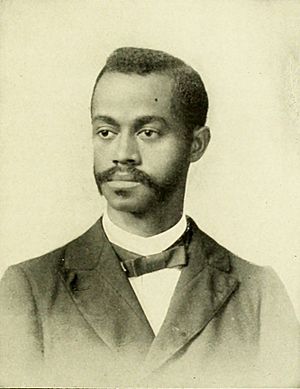Charles Henry Turner (zoologist) facts for kids
Quick facts for kids
Charles Henry Turner
|
|
|---|---|

Charles Henry Turner aged about 35
|
|
| Born | February 3, 1867 |
| Died | February 14, 1923 (aged 56) |
| Nationality | American |
| Education | |
| Scientific career | |
| Fields | Zoology |
Charles Henry Turner (born February 3, 1867 – died February 14, 1923) was an American scientist who studied animals, especially insects. He was also a teacher. He is famous for his research on how insects like bees and ants behave.
Turner was born in Cincinnati, Ohio. He was the first African American to get a graduate degree from the University of Cincinnati. He was also likely the first African American to earn a PhD from the University of Chicago. Because he was Black in the 1800s, he faced unfair treatment. He spent most of his working life teaching at Sumner High School in St. Louis.
Contents
About Charles Henry Turner
His Life Story
Charles Henry Turner was born in Cincinnati, Ohio, on February 3, 1867. This was just two years after the American Civil War ended. His father, Thomas Turner, worked as a church custodian, and his mother, Addie Campbell, was a nurse.
In 1886, he married Leontine Troy. They had three children: Henry Owen, Louise Mae, and Darwin Romanes. After Leontine passed away in 1895, Turner married Lillian Porter around 1907 or 1908. Charles Henry Turner died in Chicago on February 14, 1923, due to an illness. He was buried in Chicago's Lincoln Cemetery.
His School and Work
Turner was a very smart student. In 1886, he graduated at the top of his class from Woodward High School. He then went to the University of Cincinnati and earned a Bachelor of Science (BS) degree in biology in 1891. While there, a professor named Clarence L. Herrick helped him with his studies.
A summary of Turner's college project about bird brains was published in the famous journal Science in 1891. This made him the first African American to have his work recognized in this way. He continued his studies at the University of Cincinnati and received his Master of Science (MS) degree in 1892.
After getting his master's, Turner taught at the University of Cincinnati for a short time. He then became a professor and head of the Science Department at Clark University in Atlanta, Georgia. A building at Clark University, Turner-Tanner Hall, is now named in his honor.
Later, Turner taught at high schools. In 1906, he was a principal in Cleveland, Tennessee. Then, in 1907, he became a biology and chemistry professor at the Haines Normal and Industrial Institute in Augusta, Georgia. While teaching, he also worked on his PhD in zoology at the University of Chicago. He earned his PhD in 1907 with high honors. He was one of the first African Americans to receive a doctorate from the University of Chicago.
In 1908, Turner started teaching at Sumner High School in St. Louis. He stayed there until he retired in 1922 because of poor health. It is thought that he may have taught high school because it was hard for him to find a permanent university job at that time.
What He Discovered About Insects
Charles Henry Turner published 49 scientific papers about insects and other small creatures. Many of these papers were written while he was teaching high school. Some of his famous studies include "Habits of Mound-Building Ants" and "Experiments on the Color Vision of the Honeybee."
Turner made some amazing discoveries:
- He was the first person to prove that insects can hear sounds and tell the difference between high and low pitches.
- He discovered that cockroaches can learn by trying different things until they find the right solution (this is called trial and error).
- He found out that honeybees can see different visual patterns.
Turner's way of studying animals was special for his time. He thought that insects could learn, remember, and even have expectations. Most scientists back then believed that insects only reacted to things automatically. Turner's ideas about animal thinking were ahead of his time and became more popular much later.
He did a lot of his bee research at O'Fallon Park in North St. Louis, Missouri.
Other Important Work
Besides his science, Charles Henry Turner also worked hard to improve social and educational services for African Americans in St. Louis, Missouri. After he passed away, a school for children with disabilities was named in his honor: The Charles Henry Turner Open Air School for Crippled Children. It was later renamed Turner Middle School.

